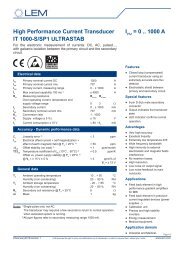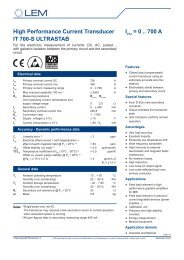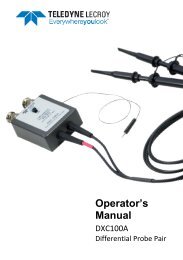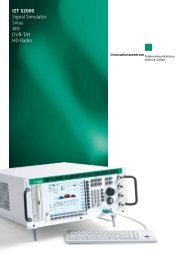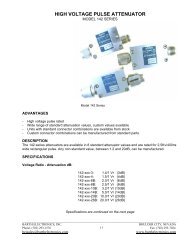DA 1855A - Operator's Manual - Teledyne LeCroy
DA 1855A - Operator's Manual - Teledyne LeCroy
DA 1855A - Operator's Manual - Teledyne LeCroy
Create successful ePaper yourself
Turn your PDF publications into a flip-book with our unique Google optimized e-Paper software.
Operator’s <strong>Manual</strong><br />
PVG to null out an input voltage up to ± 155.00 Volt which is ten times larger than the actual PVG<br />
voltage.<br />
The increase in common mode voltage range also applies when using attenuating probes.<br />
When the <strong>DA</strong><strong>1855A</strong> is used with attenuating probes that feature readout, the PVG display is<br />
changed to indicate the voltage at the +INPUT probe tip which will bring the amplifier output to<br />
zero.<br />
When connected to a <strong>Teledyne</strong> <strong>LeCroy</strong> oscilloscope via the ProBus interface, the oscilloscope<br />
OFFSET control increments or decrements the PVG’s output voltage and the offset value will be<br />
shown on the six PVG front panel indicators. The new offset value will also be displayed on the<br />
oscilloscope’s screen for a few seconds after a change has been made.<br />
When connected to an oscilloscope not provided with a ProBus interface, the PVG can be accessed<br />
by means of push buttons. Above each digit is a push button which increments the corresponding<br />
digit by one when pushed. When held, the digit continues to increment, eventually incrementing the<br />
next higher digit.<br />
Similarly, below each digit is a push button which decrements the corresponding digit.<br />
The ± button above the left-most digit changes the PVG output polarity. The ZERO button below the<br />
left-most digit sets the output to zero and invokes the PVG's Auto Zero function. PVG absolute<br />
mode: <strong>DA</strong>1855 PVG increment and decrement buttons always function to increment or decrement<br />
the voltage display respectively. When decrementing from a positive voltage, the display always<br />
stops at zero. To obtain negative voltages, the ±± button must be pushed, and the increment button<br />
is used to increase the magnitude of the negative voltage. This operation is natural if simply setting<br />
a voltage, but unnatural if moving a displayed oscilloscope waveform. This is known as the PVG<br />
absolute mode, and the only mode available in the original <strong>DA</strong>1855, (non “A” model). The <strong>DA</strong><strong>1855A</strong><br />
retains the option of operating in this same manner as well as supporting PVG roll through zero<br />
mode.<br />
NOTE: When the <strong>DA</strong><strong>1855A</strong> is controlled remotely through a <strong>Teledyne</strong> <strong>LeCroy</strong> oscilloscope, neither<br />
PVG absolute or PVG roll through zero modes apply. When operated remotely, the PVG value is<br />
controlled with the use of the OFFSET knob on the oscilloscope, when in effect, operates in the roll<br />
through mode.<br />
PVG roll through zero mode: The <strong>DA</strong><strong>1855A</strong> increment buttons are oscilloscope waveform related by<br />
factory default. The increment buttons move a displayed oscilloscope waveform upward and the<br />
decrement buttons move the waveform downward independent of the PVG polarity. Decrements<br />
from a positive voltage will roll smoothly through zero. This is known as roll through zero mode.<br />
Toggle PVG modes: To change from roll through zero to absolute mode of operation hold the PVG<br />
ZERO button and press the ± button. Change back to the roll through zero mode by repeating the<br />
same operation.<br />
922258-00 Rev A 15



